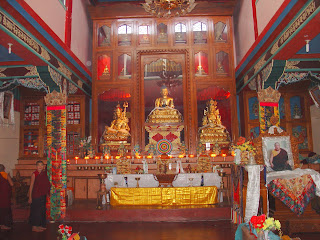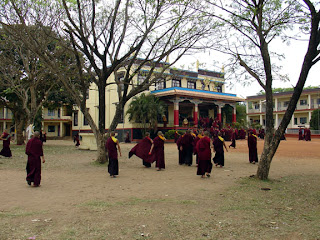Weather: I'm so cold here in Canada! I can't stop saying 'a-choo' which is 'brrrrr' in Tibetan. It is only -15C at the moment, but could go down to -30C at any time. Luckily we have heated homes and cars. I've spend winters in Nepal, without heating that's cold indeed. In South India it never drops below 15C.
Accommodation: I'm staying in the house where I grew up. It is just the three of us most of the time. Once people go back to work, I will have plenty of time alone. Outside of my room at the nunnery, I am never alone. The nunnery isn't crowded so much as very full.
Noise: It is so quiet here. Of course one might expect a monastery to be quiet, but with hundreds of nuns under the age of 20, there is plenty background noise. While I was studying for my exams last month a teenage nun set up camp under my window. She was chanting very loudly, reading not only prayers, but also chanting her way through the subjects which would be coming on her own exams. She would even chant the spelling of English words. Luckily after a few days she found another place to study. I was close to looking for things to
Food: The nunnery food is fairly simple. One day lunch is rice and lentil soup, the next day bread and vegetables. Dinner is rice gruel or flour gruel. I cook for myself, but even then, my menu is similar day to day. But here in Canada... wow! So much variety. Just seeing a full fridge and pantry is such a trip. Since I've gotten home I keep eating nachos and cheese, my favorite meal. If I gain a lot of weight here, that's okay-- in traditional Tibetan culture fat is handsome, and loosing weight brings concern. Many times nuns have told me, "We would love to be as fat and white as you." I tell them, "Drink milk, eat a lot." Honestly though, I hate being white. Maybe if I drink more chocolate milk...
Shopping: We've done some boxing day shopping here. Apparently if the Canadian salespeople are on commission they can be just as pushy and deceptive as some of their Indian counterparts. I do like the fixed prices here. In India it is rude not to haggle a bit, but I just can't do it. Over time certain merchants have taken pity on me for my lack of haggling; they just tell me the real price instead of the 'foreigner price'.
Culture: The longer I stay in Canada, the weirder it seems to be a Buddhist nun. In India, shaved heads and robes are normal. Western culture is confusing. Do people really think that they will be happier with a new car or a slimmer body? It is always such a relief to go back to India. India is a special place for spiritual development. However, India does has a booming middle class with goals and interests similar to the West. A lot of the younger nuns follow Indian Idol. The monks go mad about soccer, just like in The Cup. But the goals which guide our lives are spiritual.
Friends: Since joining Facebook this year I have reconnected with many old friends and classmates in Canada. It will be fun to meet people I haven't seen in 10 or 15 years! Back in India I've been something of a hermit for the last 5 months or so. Everyone says the fourth year of shedra (college) is one of the hardest. I've had to study a lot, to the utter dissolution of my social life. But most of my friends are shedra students or alumni, so they understand and haven't totally given up on me.


















